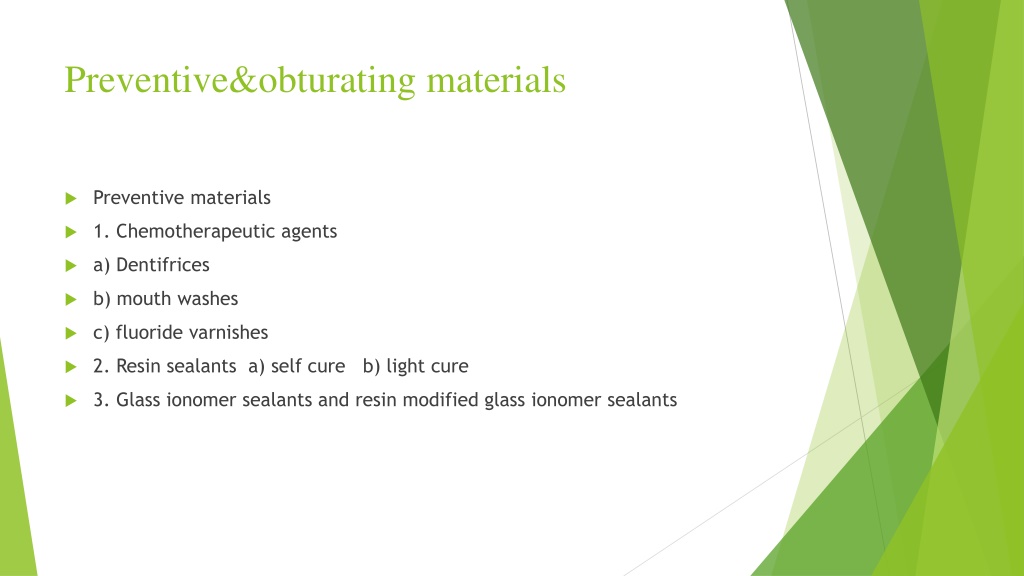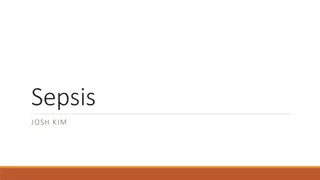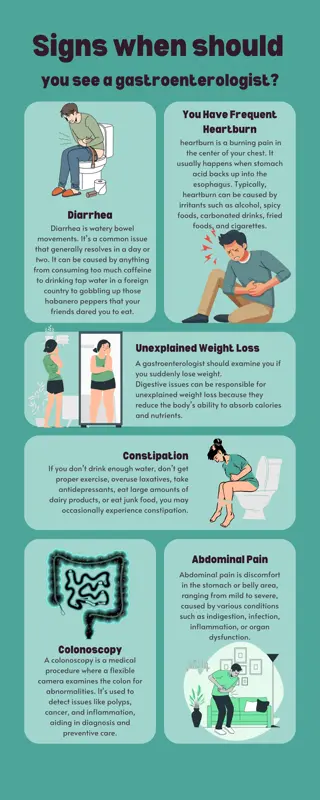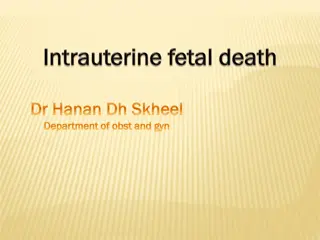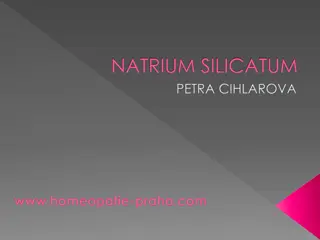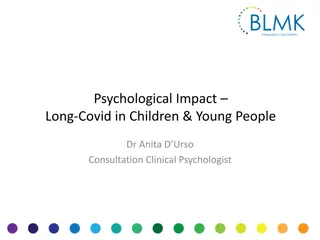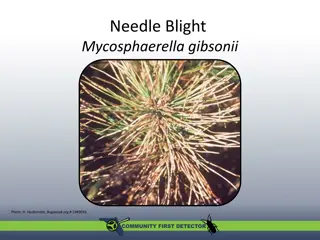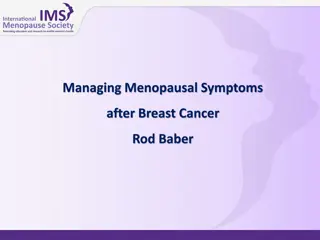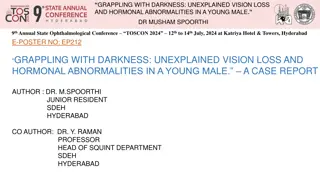Case Presentation: Unexplained Symptoms in a Young Woman
A 25-year-old woman presents with weakness, weight loss, heart rate instability, and arthralgia without arthritis. Extensive laboratory workup reveals abnormal cortisol levels, electrolyte imbalances, and other findings. Further investigations are needed to determine the underlying cause of her symptoms.
Download Presentation

Please find below an Image/Link to download the presentation.
The content on the website is provided AS IS for your information and personal use only. It may not be sold, licensed, or shared on other websites without obtaining consent from the author. Download presentation by click this link. If you encounter any issues during the download, it is possible that the publisher has removed the file from their server.
E N D
Presentation Transcript
Preventive&obturating materials Preventive materials 1. Chemotherapeutic agents a) Dentifrices b) mouth washes c) fluoride varnishes 2. Resin sealants a) self cure b) light cure 3. Glass ionomer sealants and resin modified glass ionomer sealants
Dentifrices( tooth paste) Function of tooth pastes 1. Enhance cleaning of exposed tooth surfaces 2. Removal of pellicle ,plaque ,and debris 3. Carrier for fluoride, detergents, abrasives and whitening agents to improve esthetic of teeth.
General composition of tooth pastes 1. Colloidal binding agents: they act as carrier for the active ingredients ex: sodium alginate. 2. Preservatives to inhibit bacterial growth within the paste. 3. Flavouring agents: peppermints, wintergreen, cinnamon 4. Abrasives: aid in the removal of heavy plaque and adhered stains and calculus ,like calcium pyrophosphate. 5. Humectants :to stabilize the composition and reduce the water loss by evaporation 6. Detergents: like sodium lauryl sulfate to reduce surface tension and enhance removal of debris 7. Therapeutic agents: like stannous fluoride to improve resistance to caries 0.025- 0.15% 8. Other chemicals: minor amounts to reduce corrosion, give color, remove discoloration.
Mouth washes: They are composed of three main ingredients: 1. Active agents which is selected for specific health care benefit such as anticarious activity, anti microbial effect, fluoride delivery or reduction of plaque adhesion 2. Solution of water or alcohol to dissolve the active agents 3. Surfactants: help to remove debris and dissolve other ingredients, flavoring agents to breath freshness like eucalyptol, menthol and thymol.
The main active ingredients are Chlorhexidine and fluoride Disadvantages : 1. high ethanol content produce softening effect on resin restoration 2. Staining effect of chlorhexidine and euogenol in some mouth washes 3. Toxcicity with high ethanol content
Fluoride varnishes: The fluoride is dissolved in organic solvent that evaporate when applied or sets when exposed to moisture leaving thin film of calcium fluoride deposited on the tooth surface which later converted to fluroapatite by remineralization reaction. It differs from mouth wash its action last for several hours before vanish wears while the mouth wash for seconds. It is used in young children with high risk of caries ,also in old patients to prevent root caries Disadvantages: bitter taste and tooth discoloration which is transient.
Pit and fissure sealants: Deep pits and fissures are difficult to clean and more susceptible to caries and fluoride treatment was least effective in prevention of caries. In 1965 the first technique was called occlusal sealing. Methyl -2- cyanoacrylate mixed with polymethyl methacrylate and inorganic powder. Then placed in the pits and fissures and cyanoacrylate polymerize when exposed to moisture.
Glass ionomer sealants Requirements of dental sealants: 1. high flow and good wetting to the surface 2. good wear resistance 3. high compressive strength and rigidity 4. tooth colored
5. less solubility 6. good bond to tooth 7. coefficient of expansion and contraction compatible with the tooth.
Endodontic instruments These are instruments used to remove the pulp tissue during root canal treatments 1. Stainless steal: They are either hand use or motor driven , they are either reamers or files
Properties a. High torsion strength b. High bending strength c. Corrosion resistant d. Good cutting ability e. Sterilization should not have bad effect on the cutting ability or on corrosion resistance
2. Nickel-titanium: These have higher strength and lower modulus of elasticity and are super elastic than stainless steal instruments . Obturating materials: material that will fill the canal space and may or may not be used with a sealer. Obturating materials can be classified as: 1. Solid materials. 2. Semisolid (paste or softened form).
Desirable properties of obturating materials: 1. Easily introduced into the canal. 2. Seal the canal laterally and apically. 3. Not shrink after being inserted. 4. They should be impervious to moisture. 5. They should be bactericidal or reduced bacterial growth. 6. Radiopaque. 7. Not stain tooth structure. 8. Not irritant to periapical tissue or affect tooth structure. 9. Easily sterilized. 10. Easily removed from the root canal.
Solid Obturating materials: The most common type of these materials is: Gutta- Percha and Synthetic resin- based core material. The major advantage of these materials is the ability to control length, as well as the reasonable ability to adapt to irregularities and to create an adequate seal.
Gutta- Percha: It is the standard to which other materials are compared because of its advantages like: Plasticity (it adapts with compaction to irregularities in prepared canal). Easy to manipulate. Easy to remove either partially or totally. It has relatively little toxicity. It tends to be self sterilizing (if there is a possibility to be contaminated they are predictably sterilized by immersion in 1% sodium hypochlorite for 1 minute).
Disadvantages: 1. It lacks adhesion to dentine and a slight elasticity, which causes a rebound and pulling away from the canal wall. 2. Warmed gutta- percha shrinks during cooling, also after evaporation of a solvent when immersed for sterilizing.
Composition: 1. Zinc oxide (+ 75%). 2. Gutta- perch (20% give plasticity). 3. Binders. 4. Opaque material. 5. Coloring agents. Shapes: Gutta- Percha cones are available in two basic shapes: 1. Standardized cones are designed to have the same size and taper as the corresponding to endodontic instruments (No.40 cone corresponding to No.40 file). 2. Conventional cones the tip of the cone has one size and the body of the cone another
Resin obturating material: As a potential replacement for Gutta- Percha, the core material is polycaprolactone with fillers of bioactive glass and other components; this combination an attempt to form a single entity or monoblock in the root canal system. Shapes: conventional and standardized. Advantages of Resin obturating material: 1. Noncytotoxic material. 2. Biocompatible. 3. No mutagenic
